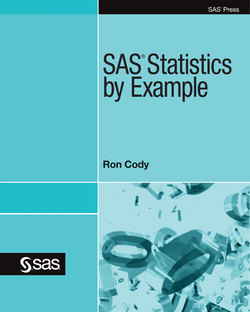Читать книгу SAS Statistics by Example - Ron Cody EdD - Страница 5
ОглавлениеList of Programs
Program 1.1: Using PROC PRINT to List the Observations in a SAS Data Set
Program 1.2: Using PROC CONTENTS to Display the Data Descriptor Portion of a SAS Data Set
Program 1.3: Reading Data from a Text File That Uses Spaces as Delimiters
Program 1.4: Using PROC PRINT to List the Observations in Data Set Sample2
Program 1.5: Reading a CSV File
Program 2.1: Generating Descriptive Statistics with PROC MEANS
Program 2.2: Statistics Broken Down by a Classification Variable
Program 2.3: Demonstrating the PRINTALLTYPES Option with PROC MEANS
Program 2.4: Computing a 95% Confidence Interval
Program 2.5: Producing Histograms and Probability Plots Using PROC UNIVARIATE
Program 2.6: Using PROC SGPLOT to Produce a Histogram
Program 2.7: Using SGPLOT to Produce a Horizontal Box Plot
Program 2.8: Displaying Outliers in a Box Plot
Program 2.9: Labeling Outliers on a Box Plot
Program 2.10: Displaying Multiple Box Plots for Each Value of a Categorical Variable
Program 3.1: Computing Frequencies and Percentages Using PROC FREQ
Program 3.2: Demonstrating the NOCUM Tables Option
Program 3.3: Demonstrating the Effect of the MISSING Option with PROC FREQ
Program 3.4: Computing Frequencies on a Continuous Variable
Program 3.5: Writing a Format for Gender, SBP, and DBP
Program 3.6: Generating a Bar Chart Using PROC GCHART
Program 3.7: Generating a Bar Chart Using PROC SGPLOT
Program 3.8: Using ODS to Create PDF Output
Program 3.9: Creating a Cross-Tabulation Table Using PROC FREQ
Program 3.10: Changing the Order of Values in a PROC FREQ Table By Using Formats
Program 4.1: Creating a Scatter Plot Using PROC GPLOT
Program 4.2: Adding Gender Information to the Plot
Program 4.3: Using PROC SGPLOT to Produce a Scatter Plot
Program 4.4: Adding Gender to the Scatter Plot Using PROC SGPLOT
Program 4.5: Demonstrating the PLOT Statement of PROC SGSCATTER
Program 4.6: Demonstrating the COMPARE Statement of PROC SGSCATTER
Program 4.7: Switching the x- and y-Axes and Adding a GROUP= Option
Program 4.8: Producing a Scatter Plot Matrix
Program 5.1: Conducting a One-Sample t-test Using PROC TTEST
Program 5.2: Demonstrating ODS Graphics with PROC TTEST
Program 5.3: Conducting a One-Sample t-test
Program 5.4: Conducting a One-Sample Test with a Nonzero Null Hypothesis
Program 5.5: Testing Whether a Variable is Normally Distributed
Program 6.1: Conducting a Two-Sample t-test
Program 6.2: Demonstrating ODS Graphics
Program 6.3: Selecting Plots Using the PLOT Option for PROC TTEST
Program 6.4: Conducting a Paired t-test
Program 6.5: Using ODS Plots to Test t-Test Assumptions
Program 7.1: Running a One-Way ANOVA
Program 7.2: Requesting Multiple Comparison Tests
Program 7.3: Using ODS Graphics to Produce a Diffogram1
Program 7.4: Performing a Two-Way Factorial Design
Program 7.5: Analyzing a Factorial Design with Significant Interactions
Program 7.6: Analyzing a Randomized Block Design
Program 8.1: Producing Correlations between Two Sets of Variables
Program 8.2: Producing a Correlation Matrix
Program 8.3: Creating HTML Output That Contains Data Tips
Program 8.4: Generating Spearman Rank Correlations
Program 8.5: Running a Simple Linear Regression Model
Program 8.6: Displaying Influential Observations
Program 8.7: Predicting Values Using the Regression Equation
Program 8.8: Using PROC REG to Compute Predicted Values
Program 8.9: Describing a More Efficient Way to Compute Predicted Values
Program 8.10: Using PROC SCORE to Compute Predicted Values from a Regression Model
Program 9.1: Running a Multiple Regression Model
Program 9.2: Using the RSQUARE Selection Method to Execute All Possible Models
Program 9.3: Generating Plots of R-Square, Adjusted R-Square, and Cp
Program 9.4: Demonstrating Forward, Backward, and Stepwise Selection Methods
Program 9.5: Setting the SLENTRY Value to .15 Using the Forward Selection Method
Program 9.6: Forcing Variables into a Stepwise Model
Program 9.7: Creating Dummy Variables for Regression
Program 9.8: Running PROG REG with Dummy Variables for Gender and Region
Program 9.9: Using the VIF to Detect Collinearity
Program 9.10: Detecting Influential Observations in Multiple Regression
Program 10.1: Comparing Proportions Using Chi-Square
Program 10.2: Rearranging Rows and Columns in a Table and Computing Relative Risk
Program 10.3: Tables with Small Expected Frequencies–Fisher’s Exact Test
Program 10.4: Computing Chi-Square from Frequency Data
Program 10.5: A SAS Macro for Computing Chi-Square from Cell Frequencies
Program 10.6: Computing Kappa Coefficient of Agreement
Program 10.7: Demonstrating Two Tests for Trend
Program 10.8: Computing Chi-Square for a One-Way Table
Program 11.1: Logistic Regression with One Categorical Predictor Variable
Program 11.2: Logistic Regression with One Continuous Predictor Variable
Program 11.3: Using a Format to Create a Categorical Variable
Program 11.4: Using a Combination of Categorical and Continuous Variables
Program 11.5: Running a Logistic Model with Interactions
Program 12.1: Plotting the Distribution of Income
Program 12.2: Performing a Wilcoxon Rank-Sum Test (aka Mann-Whitney U Test)
Program 12.3: Requesting an Exact p-Value for a Wilcoxon Rank-Sum Test
Program 12.4: Performing a Wilcoxon Signed-Rank Test
Program 12.5: Performing a Kruskal-Wallis ANOVA
Program 12.6: Performing the Ansari-Bradley Test for Spread
Program 12.7: Demonstrating PROC RANK
Program 12.8: Replacing Values with Ranks and Running a t-Test
Program 12.9: Using PROC RANK to Create Groups
Program 13.1: Computing Sample Size for an Unpaired t-Test
Program 13.2: Computing the Power of a t-Test
Program 13.3: Computing the Power for an ANOVA Design
Program 13.4: Computing Sample Size for a Difference in Two Proportions
Program 14.1: Taking a Simple Random Sample
Program 14.2: Taking a Random Sample with Replacement
Program 14.3: Rerunning the Program without the OUTHITS Option
Program 14.4: Requesting Replicate Samples
